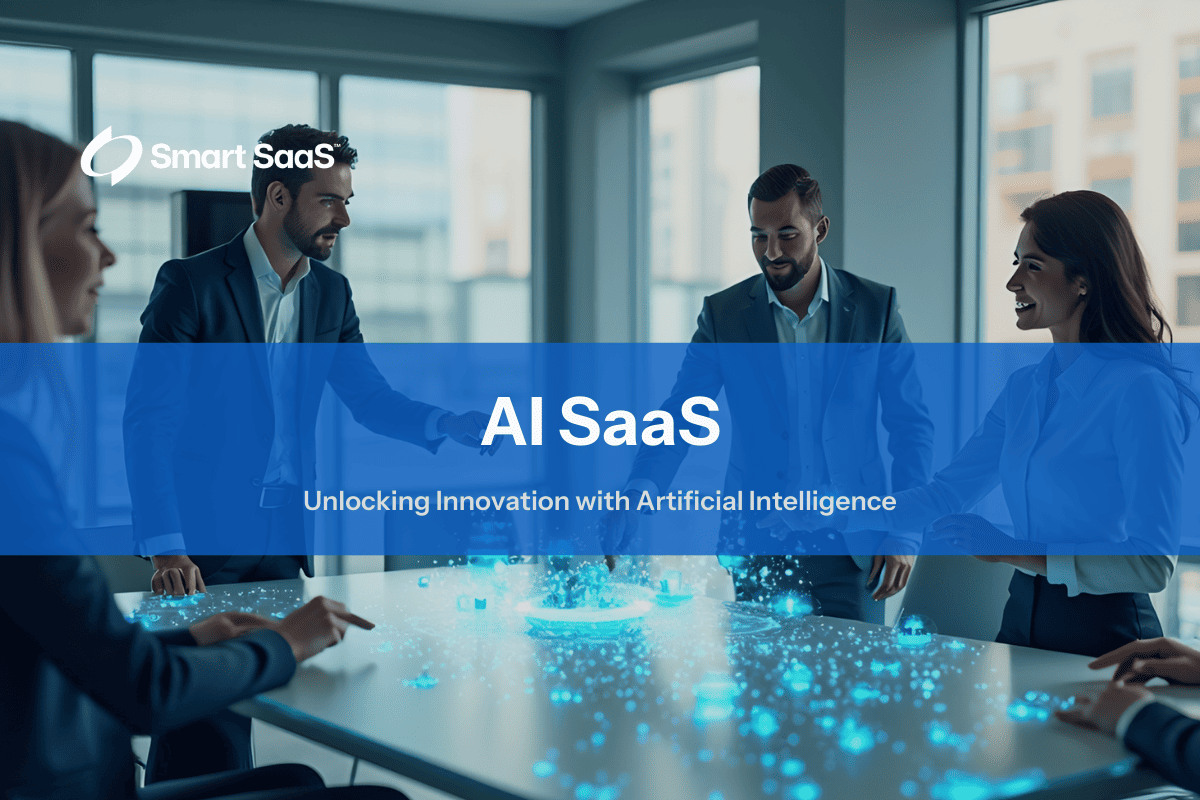

Friday, March 7, 2025
Kevin Anderson
As artificial intelligence (AI) evolves from a futuristic concept into a practical staple of modern technology, Software as a Service (SaaS) providers are increasingly integrating AI to deliver cutting-edge, cloud‑based solutions. The result is AI SaaS—a powerful synergy of machine learning integration, predictive analytics, and seamless cloud computing, all packaged in a flexible subscription model. From generative AI content creation to advanced data analytics for customer insights, AI is reshaping the traditional SaaS landscape across industries such as finance, healthcare, manufacturing, and beyond.
However, rapid innovation also carries new risks. As highlighted in the eBook Escape the SaaS Trap, businesses adopting SaaS need to be aware of hidden costs, limited data ownership, and potential vendor lock‑in that can arise from vendor‑focused models. With AI in the mix, these dynamics become even more significant: companies must navigate complex data governance concerns, evaluate vendor transparency, and ensure that the solution truly serves their long‑term strategic goals. This article will explore what AI SaaS is, which companies are leading the space, and how to harness AI in SaaS platforms while avoiding common pitfalls. In doing so, it provides a comprehensive roadmap for leveraging AI to unlock innovation and gain a competitive edge.

AI SaaS refers to SaaS platforms that incorporate artificial intelligence and machine learning to deliver advanced automation, data‑driven insights, and predictive capabilities to users. Instead of deploying AI models on local servers, businesses subscribe to AI‑powered SaaS services via the cloud, thereby benefiting from continuous updates, real‑time analytics, and vendor‑managed infrastructure.
Typical applications include automated customer support, conversational AI chatbots, recommendation engines, and intelligent data processing tools. In essence, adding AI to SaaS introduces cognitive layers that learn from user interactions, business data, and evolving market trends. For a deeper dive into the digital transformation that underpins these innovations, consider our article on digital transformation.
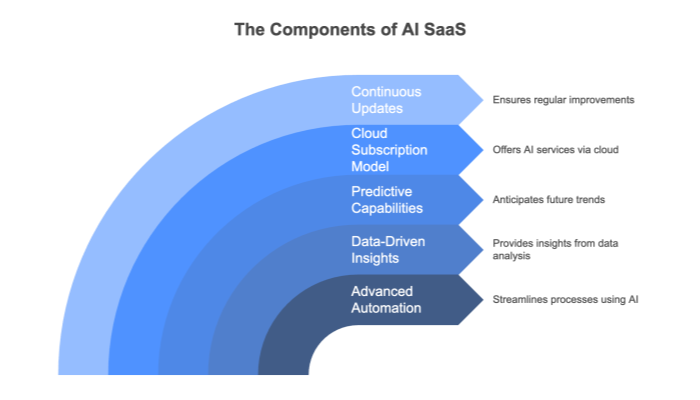

While standard SaaS models rely on cloud‑based hosting and subscription pricing, the integration of AI elevates the overall experience by providing personalized user experiences, enhanced efficiency, smarter decision‑making, and adaptive workflows.
AI SaaS tools analyze behavioral patterns and operational data to tailor interfaces, dashboards, and recommendations to individual user needs, ensuring that the software evolves with your business.
This technology not only automates mundane tasks but also empowers executives to make informed, data‑backed decisions. For instance, in the context of real‑time analytics and continuous learning, companies can better predict market trends and optimize operations.
To learn more about how businesses can get started with these innovations, visit our guide on getting started with digital transformation.
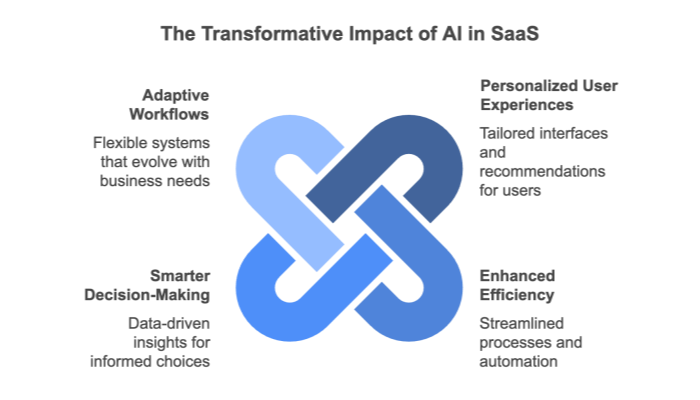

AI is revolutionizing SaaS platforms in multiple dimensions. Through predictive analytics, AI models forecast future outcomes based on historical data, helping companies in sales, finance, and supply chain management to optimize their operations. Additionally, AI automates numerous tasks that once required manual intervention, thereby freeing up valuable human resources. In this section, we explore several key areas where AI integration is making a significant impact.
One of the most transformative aspects of AI in SaaS is its ability to predict future trends using historical data and advanced machine learning algorithms. In sales and CRM, for example, AI can forecast deal closure probabilities and identify upsell opportunities.
In finance, it detects fraudulent transactions and automates invoicing processes. In supply chain management, AI anticipates inventory shortages and optimizes logistics in real time. By automating these processes, AI helps businesses reduce manual workloads and increase operational efficiency.
For further insights on AI's impact, see our discussion on understanding AI SaaS companies.
AI-driven SaaS-based content marketing solutions are transforming how marketing teams operate. By analyzing customer data, social media interactions, and past campaign performance, these tools generate personalized content recommendations and can even craft entire email campaigns automatically.
In addition, conversational AI chatbots provide round‑the‑clock customer service by handling queries, scheduling appointments, and guiding users through product demos without human intervention. This not only streamlines customer engagement but also enhances overall satisfaction. For more details on modern SaaS trends, explore our article on vertical SaaS innovation.
In the B2B arena, AI SaaS solutions focus on optimizing large-scale processes. For instance, predictive maintenance uses sensor data to identify potential machinery failures before they occur, while intelligent HR management tools can automate candidate screening and predict employee attrition.
In finance and accounting, AI automates data extraction from invoices and expense reports, significantly reducing error rates and speeding up auditing processes. This tailored integration of AI in SaaS empowers providers to offer specialized modules that deliver immediate ROI while carving out a competitive niche.
Learn more about innovative SaaS business strategies in our post on building a successful SaaS business model.
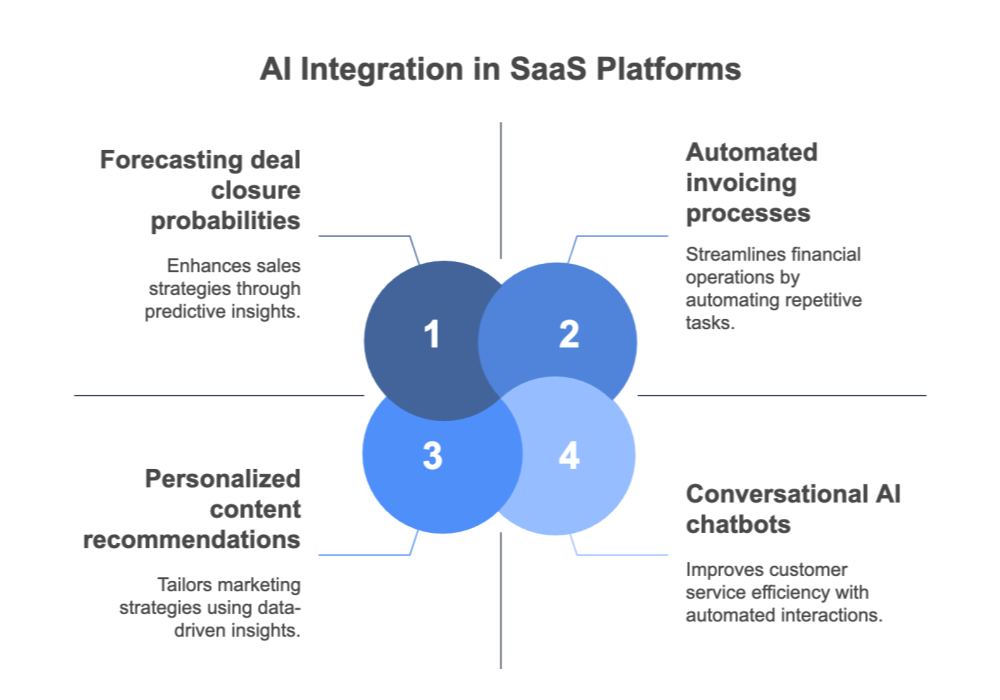

The AI SaaS market is dynamic, with several pioneering companies driving innovation by integrating advanced machine learning and predictive analytics into their platforms.
These leading innovators are setting industry benchmarks and redefining how businesses leverage AI in their everyday operations. In this section, we highlight some of the top AI SaaS companies and discuss their groundbreaking contributions.
Some companies have made notable strides in embedding AI into SaaS. Salesforce Einstein integrates AI directly into its CRM, providing features such as lead scoring and personalized email recommendations that enhance sales productivity.
Adobe Sensei uses deep learning for image recognition and automated design suggestions, revolutionizing creative workflows. Shopify leverages AI for personalized product recommendations and fraud detection, improving both merchant and consumer experiences. Additionally, HubSpot employs AI to optimize marketing campaigns by analyzing engagement data to suggest content improvements.
For more on SaaS innovation, read our article on what is SaaS.
White‑label AI SaaS solutions allow companies to rebrand and resell advanced AI functionalities under their own name. This approach is especially beneficial for agencies and consultants who want to offer cutting‑edge AI features without the need for extensive in‑house development. By leveraging white‑label solutions, these businesses can tailor interfaces, customize workflows, and set unique pricing models that align with their brand identity and customer needs.

AI SaaS tools are not only enhancing traditional business operations but also driving new levels of efficiency and innovation. These tools encompass generative AI for content creation, analytics platforms for business intelligence, and modular AI solutions that can be integrated into existing workflows. Their ability to automate tasks and provide real‑time insights has made them indispensable for organizations looking to streamline operations and gain a competitive advantage.
Generative AI has the power to revolutionize content creation by automating the production of text, images, and even code. Marketing teams can use these tools to generate blog posts, social media content, and product descriptions quickly and efficiently.
This not only reduces the time-to-market but also ensures that content remains fresh and relevant. However, as noted in our discussion on AI readiness, transparency in AI-generated content is essential to prevent the spread of inaccuracies.
Increasingly, businesses are turning to AI SaaS products that streamline analytics and business intelligence. These platforms leverage AI to transform raw data into actionable insights through automated data visualization, predictive analytics, and multi‑channel integration. They enable organizations to quickly identify trends, spot revenue leaks, and optimize marketing campaigns.
For an integrated view of how SaaS drives business value, check out our article on the SaaS business model.
White-label AI SaaS solutions provide companies with the flexibility to rebrand advanced AI tools as their own. This approach is particularly useful in the B2B sector, where agencies and software vendors can offer specialized solutions without developing complex AI models from scratch.
These white-label offerings enable businesses to deliver personalized user experiences, optimize workflows, and maintain cost-effective operations while building a unique market presence.


The future of AI SaaS is filled with exciting possibilities as emerging technologies continue to push the boundaries of innovation. From personalized learning systems to AI SaaS builder platforms, the market is evolving rapidly.
New trends such as vertical‑specific AI, low‑code/no‑code development environments, and advanced generative models are set to revolutionize how SaaS solutions are built and deployed. This evolution is not just about adding new features; it represents a paradigm shift towards more adaptive, user‑centric, and scalable software solutions.
The AI SaaS market is brimming with potential innovations. Personalized learning platforms powered by AI are transforming education by adapting to individual student needs. AI SaaS builder platforms are emerging, allowing users to assemble AI components with minimal technical expertise.
Vertical‑specific AI solutions are tailored to meet the unique demands of industries such as healthcare, construction, and retail, ensuring compliance and delivering specialized insights. For more on the strategic value of these innovations, see our article on vertical SaaS.
Despite its enormous potential, integrating AI into SaaS platforms comes with challenges. Data privacy issues, vendor lock‑in, workforce skill gaps, and the need for continuous model updates are significant hurdles.
Companies must ensure that they maintain control over their data and have flexible contracts to avoid becoming overly dependent on a single vendor. Addressing these challenges requires a proactive approach and an investment in training and advanced analytics. Learn more about mitigating these risks in our post on SaaS security challenges.
Looking ahead, B2B SaaS solutions will increasingly incorporate AI to deliver hyper‑personalized experiences. AI will enable the creation of customized dashboards and workflows tailored to individual user segments.
This evolution will foster better collaboration and more efficient processes by providing real‑time insights and automated recommendations. Companies can leverage these advancements to streamline operations and enhance decision‑making.
For additional insights into AI’s role in SaaS, refer to our article on understanding AI SaaS companies.


AI SaaS platforms offer transformative benefits that drive scalability, efficiency, and innovation. By leveraging cloud‑based AI, companies can automate routine tasks, achieve rapid deployment of new features, and reduce the need for significant upfront investment in AI infrastructure.
The cost‑effective subscription model allows businesses to access advanced analytics and automation without compromising on quality. Moreover, AI SaaS helps mitigate risks by providing real‑time alerts and predictive insights that preempt potential issues. For example, an eCommerce startup can scale dynamically during high‑traffic events and lower costs during slow periods, enhancing overall profitability.
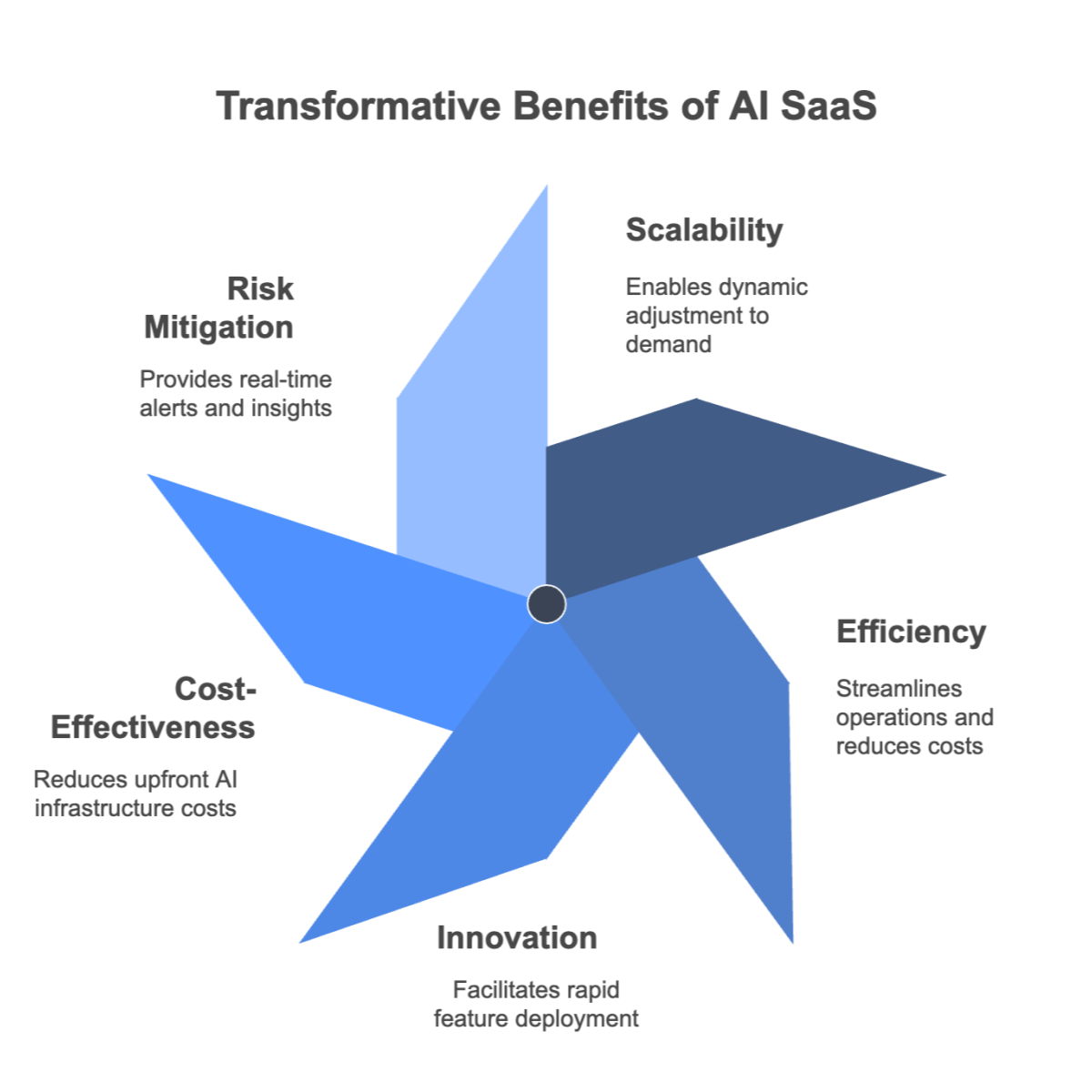

Across various industries, AI SaaS solutions are being deployed to drive tangible improvements. In financial services, AI aids in fraud detection and credit scoring, while healthcare applications utilize AI for patient triage and risk assessment. In retail, personalized product recommendations and dynamic pricing models are transforming customer engagement.
Manufacturing benefits from predictive maintenance and quality control through computer vision, ensuring minimal downtime and optimal performance. These real-world applications not only showcase the versatility of AI SaaS but also highlight its potential to deliver substantial return on investment.
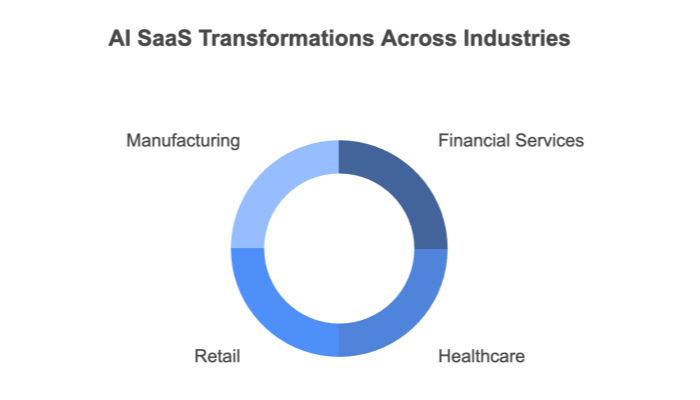

While the benefits of AI SaaS are considerable, integrating advanced AI capabilities into existing SaaS platforms presents several challenges. One of the most significant is ensuring data quality; AI algorithms require high‑quality, well‑labeled data to function effectively.
Additionally, model explainability remains an issue—particularly for deep learning systems where the decision-making process is opaque, which can be problematic in regulated industries. Balancing the performance of large AI models with cost‑effectiveness is another critical challenge, as is the need for continuous updates to maintain accuracy over time.
Overcoming these challenges requires robust data governance, clear vendor communication, and ongoing investment in model training and optimization.


Generative AI is leading the next wave of innovation in SaaS by automating content creation, design, and even coding tasks. These advancements promise to reduce development time, lower operational costs, and spur creative new applications. Automated code generation tools can write, debug, and optimize code segments, while dynamic interface creation platforms generate custom UI mockups based on textual prompts. Advanced language models integrated into SaaS documentation or user guides offer real‑time support and clarification, enhancing the overall user experience.
Although these capabilities provide significant efficiency gains, it remains crucial to ensure that businesses retain control over key processes and data—an important tenet discussed in the data ownership article.


To successfully integrate AI SaaS solutions into your operations, it is essential to follow a systematic evaluation process. Begin by defining clear objectives—identify the specific problems that AI must solve, such as automating repetitive tasks, enhancing customer support, or analyzing complex data sets. Next, assess vendor transparency by ensuring that potential providers offer clear, upfront information on pricing, data usage, and their product roadmap.
Reviewing data privacy and compliance is crucial, particularly if sensitive data is involved; make sure that the solution meets industry regulations such as HIPAA or GDPR. Additionally, run a pilot project to gauge how well the AI solution integrates with your workflows and gather feedback from all stakeholders.
Finally, evaluate ongoing support and flexibility, ensuring that the provider offers regular updates and that you maintain ownership of your data. For more on vendor assessment strategies, check our guide on SaaS management platforms.


AI SaaS represents a revolutionary fusion of artificial intelligence and cloud-based software, offering unprecedented opportunities for automation, personalization, and data intelligence. From predictive analytics that forecast future trends to generative AI that automates content creation, these advanced tools are reshaping industries across finance, healthcare, manufacturing, and beyond.
However, as the insights from Escape the SaaS Trap remind us, the promise of AI must be balanced with a rigorous approach to vendor selection, data governance, and ongoing risk management. By maintaining ownership of your data, ensuring transparency in pricing and performance, and adopting a flexible, usage‑based pricing model, your organization can harness the full potential of AI SaaS while avoiding common pitfalls.
As you embark on your journey to integrate AI into your SaaS environment, remember that continuous evaluation, user training, and proactive support are key to long‑term success. Whether you are a startup exploring innovative AI solutions or an established enterprise looking to optimize your operations, the future of SaaS is adaptive, data‑driven, and full of promise. For further insights into building a robust SaaS strategy, read our related article on SaaS security challenges and effective solutions.

Ready to unlock the full potential of AI SaaS for your business? Download our free eBook, "SaaS Security Unmasked", to discover comprehensive strategies for evaluating risk factors, maintaining data ownership, and leveraging advanced AI for continuous innovation. Empower your organization with the insights and tools needed to stay ahead in today’s fast‑paced digital landscape.


Explore more insights and strategies on SaaS innovation and security: